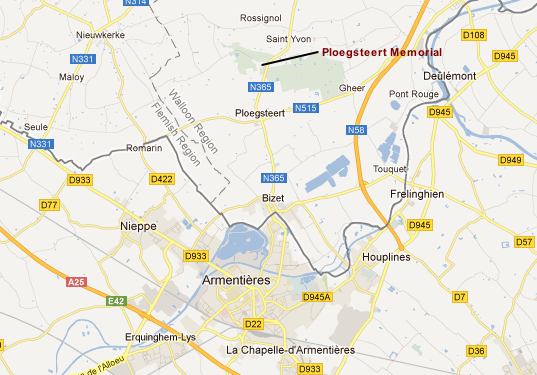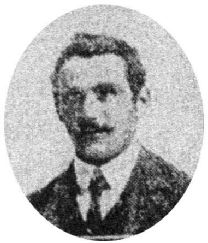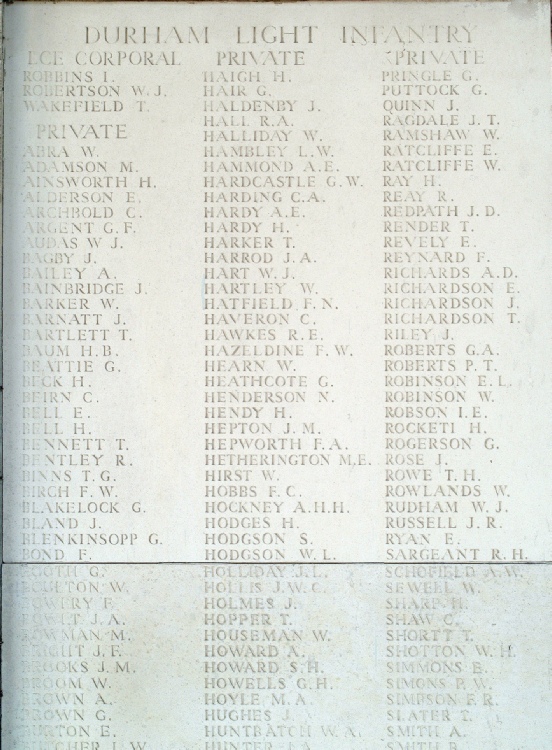
Walter Houseman
1888 - 1918
Walter Houseman was aged 27 years & 3 months when he was attested at Harrogate for entry to the
Military service on the 9 December 1915.
A medical examination took place that recorded him as standing 5’ 7” inches tall and having a chest
measurement of 36 inches. He was found fit for service.
Walter was employed as a farmer at the time of his enlistment. His address is given as Deering House
Farm, Dacre,Yorkshire.
He was single, and gave as his next of kin his mother Emma Houseman of Deering House Farm, Dacre.
He signed the declaration on the attestation form, swore an oath and received the “King’s shilling”.
He was put in to reserve, this meant that he had signed up but was sent back to civilian employment until
he was called up and on the 15 June 1916 he was mobilized and posted to the 24th King’s Royal
Rifle Corp as Rifleman number 28364.
On the 1 September he was transferred to the 91st Training Reserve Battalion as number 49668.
Military service on the 9 December 1915.
A medical examination took place that recorded him as standing 5’ 7” inches tall and having a chest
measurement of 36 inches. He was found fit for service.
Walter was employed as a farmer at the time of his enlistment. His address is given as Deering House
Farm, Dacre,Yorkshire.
He was single, and gave as his next of kin his mother Emma Houseman of Deering House Farm, Dacre.
He signed the declaration on the attestation form, swore an oath and received the “King’s shilling”.
He was put in to reserve, this meant that he had signed up but was sent back to civilian employment until
he was called up and on the 15 June 1916 he was mobilized and posted to the 24th King’s Royal
Rifle Corp as Rifleman number 28364.
On the 1 September he was transferred to the 91st Training Reserve Battalion as number 49668.
In France
Walter arrived in France on the 5 November 1916 and on the 6 November was posted to the 18th Btn
Durham Light Infantry an Private, number 6262 and on the 19 November was transferred to the 1/8th Btn
Durham Light Infantry, number 301883 as part of the 151st (Durham Light Infantry) Brigade of the 50th
(Northumbrian) Division.
Durham Light Infantry an Private, number 6262 and on the 19 November was transferred to the 1/8th Btn
Durham Light Infantry, number 301883 as part of the 151st (Durham Light Infantry) Brigade of the 50th
(Northumbrian) Division.
The Northumbrian Division was a Territorial Force Division already in existence at the outbreak of the war.
The Division and Brigades were not numbered until April 1915 previously just named Arrived in France in
April 1915.
In June 1918 the Division was so under manned that the Brigades were reformed into Battalions and
designated 149th , 150th and 151st Brigade Battalions. These Battalions formed the 50th Division
Composite Brigade. The Division was reduced to Cadre in June 1918 and reconstituted in July 1918.
Served in France and Flanders until the Armistice.
Walter served in France and Flanders, with the 50th Division, most probably taking part in:
1917
The German retreat to the Hindenburg Line (the Occupation of Peronne (18 March)).
The Second Battle of Arras ( First Battle of the Scarpe (9-14 April), First attack on Bullecourt (11 April),
German attack on Lagnicourt (13 April), Second Battle of the Scarpe (23-24 April) and the Battle of
Bullecourt (3-17 May)).
The Third Battle of Ypres ( Second Battle of Passchendaele (26 October-10 November)).
1918
The First Battle of the Somme (Battle of St Quentin (21-23 March), and the Battle of Rosieres
(20-27 March)).
The Fourth Battle of Ypres (Battle of Estaires (9-111 April) and the Battle of Hazebrouck (12-15 April)).
Walter died on the 12 April 1918 so it would seem likely that this was on the first day of fighting at the
Battle of Hazebrouck.
Because of his overseas service in a theatre of war he was awarded the British War Medal and
Victory Medal.
designated 149th , 150th and 151st Brigade Battalions. These Battalions formed the 50th Division
Composite Brigade. The Division was reduced to Cadre in June 1918 and reconstituted in July 1918.
Served in France and Flanders until the Armistice.
Walter served in France and Flanders, with the 50th Division, most probably taking part in:
1917
The German retreat to the Hindenburg Line (the Occupation of Peronne (18 March)).
The Second Battle of Arras ( First Battle of the Scarpe (9-
The Third Battle of Ypres ( Second Battle of Passchendaele (26 October-
1918
The First Battle of the Somme (Battle of St Quentin (21-
The Fourth Battle of Ypres (Battle of Estaires (9-
Walter died on the 12 April 1918 so it would seem likely that this was on the first day of fighting at the
Battle of Hazebrouck.
Because of his overseas service in a theatre of war he was awarded the British War Medal and
Victory Medal.
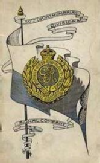
Private - service number 301883
1/8th Durham Light Infantry


The King's Royal Rifle Corp
24th (Reserve) Battalion
Formed in April 1916 from the depot companies of 21st Bn.
Moved to Blyth in May 1916 and on 19 May went to nearby Cambois.
24th (Reserve) Battalion
Formed in April 1916 from the depot companies of 21st Bn.
Moved to Blyth in May 1916 and on 19 May went to nearby Cambois.
1 September 1916 : absorbed into Training Reserve Battalions of 21st Reserve Brigade.
Battalions of the Regular Army
1st Battalion
August 1914 : in Nowshera in India. Part of the 3rd (Abbottabad) Brigade in 2nd (Rawalpindi) Division. Remained in India
throughout the war. Transferred in August 1914 to 2nd (Nowshera) Brigade in 1st (Peshawar) Division. In November 1917
transferred to 4th (Rawalpindi) Brigade in 2nd (Rawalpindi) Division.
2nd Battalion
August 1914 : at Lichfield. Part of 18th Brigade in 6th Division. Moved to Dunfermline but by 13 August was at Cambridge.
10 September 1914 : landed at St Nazaire.
3rd (Reserve) Battalion
August 1914 : at Newcastle-
4th (Extra Reserve) Battalion
August 1914 : at Barnard Castle. A depot/training unit, it moved on mobilisation to the Tyne defences. Moved in December to
Killingworth, went to Forest Hall in January 1915 and finally to Seaham Harbour in September 1915, where it then remained as
part of the Tyne Garrison.
Battalions of the Territorial Force
1/5th Battalion
August 1914 : at Stockton-
18 April 1915 : landed at Boulogne.
14 May 1915 : became 150th Brigade in 50th (Northumbrian) Division.
12 February 1918 : transferred to 151st Brigade in same Division.
15 July 1918 : reduced to cadre strength and transferred to Lines of Communication.
16 August 1918 : transferred to 117th Brigade in 39th Division.
9 November 1918 : disbanded in France.
1/6th Battalion
August 1914 : at Bishop Auckland. Part of DLI Brigade, Northumbrian Division. Moved to Bolden Colliery in early August, then
Ravensworth Park. Was at Newcastle by October.
17 April 1915 : landed at Boulogne.
14 May 1915 : became 151st Brigade in 50th (Northumbrian) Division.
3 June 1915 : after taking heavy casualties, 1/6th and 1/8th Bns merged to form 6/8th Bn. Resumed original identity 11 August
1915.
15 July 1918 : reduced to cadre strength and transferred to Lines of Communication.
16 August 1918 : transferred to 117th Brigade in 39th Division.
6 November 1918 : disbanded in France.
1/7th Battalion
August 1914 : at Sunderland. Part of DLI Brigade, Northumbrian Division. Moved to coast defences in mid August, then
Ravensworth Park. Was at Newcastle by October.
17 April 1915 : landed at Boulogne.
14 May 1915 : became 151st Brigade in 50th (Northumbrian) Division.
16 November 1915 : left Brigade and converted into Pioneer Battalion for same Division.
20 June 1918 : transferred to 8th Division.
3 July 1918 : absorbed the 22nd Bn.
1/8th Battalion
August 1914 : at Durham. Record same as 1/6th Bn.
1/9th Battalion
August 1914 : at Gateshead. Record same as 1/6th Bn.
12 February 1918 : converted into Pioneer Battalion and transferred to 62nd (2nd West Riding) Division.
2/5th Battalion
Formed at Stockton in September 1914 as a second line unit. Moved to Long Benton and placed under orders of 189th Brigade
in 63rd (2nd Northumbrian) Division. Moved to Cramlington in July 1915 and Retford in November.
July 1916 : Division broken up. 189th Brigade moved to Catterick.
31 October 1916 : left Brigade and moved to Salonika as a Garrison Battalion, going via France and arriving 15 November.
Placed under XVI Corps on arrival.
1 March 1917 : transferred to 228th Brigade in 28th Division.
2/6th Battalion
Formed at Ravensworth Park (Gateshead) 26 September as a second line unit. Moved to Leam Camp (Heworth) and placed
under orders of 190th Brigade in 63rd (2nd Northumbrian) Division. Moved to Doncaster in November 1915.
July 1916 : Division broken up. 190th Brigade moved to Catterick.
29 November 1916 : moved to Andover, going on in March 1917 to Colchester and then Frinton in September.
1 May 1918 : landed at Calais as a Garrison Guard Battalion and under orders of 177th Brigade in 59th (2nd North Midland)
Division. "Garrison Guard" title was dropped on 16 July.
2/7th Battalion
Formed at Sunderland 16 September 1914 as a second line unit. Record same as 2/6th Bn but did not sail on 1 May 1918.
September 1918 : became a Garrison Guard Battalion/
7 October 1918 : embarked for service in North Russia and landed at Archangel.
2/8th Battalion
Formed at Durham in October 1914 as a second line unit. Record same as 2/6th Bn.
29 November 1916 : moved to Basingstoke.
December 1917 : disbanded in England.
2/9th Battalion
Formed at Ravensworth Park 11 September 1914 as a second line unit. Record same as 2/6th Bn.
4 November 1916 : sailed from Southampton, moving to Salonika via France, arriving 15 November. Became Army Troops and
remained in area of Salonika town.
3/4th, 3/5th, 3/6th, 3/7th, 3/8th and 3/9th Battalions
Formed at home bases by June 1915. Moved to Catterick.
8 April 1916 : renamed as Reserve Battalions.
1 September 1916 : 5th absorbed the others at Newcastle. Moved to Redcar in October 1916 and Catterick in December.
Moved to Hornsea in summer 1917 and then in spring 1918 to Sutton-
26th Battalion
On 1 January 1917, the 23rd Provisional Bn became 26th Bn DLI. The 23rd had been formed from Home Service personnel
from the TF Bns of the regiment. Remained in England throughout the war.
27th Battalion
On 1 January 1917, the 25th Provisional Bn became 26th Bn DLI. The 25th had been formed from Home Service personnel from
the TF Bns of the regiment. Remained in England throughout the war.
Battalions of the New Armies
10th (Service) Battalion
Formed at Newcastle on 22 August 1914 as part of K1 and attached to 43rd Brigade in 14th (Light) Division. Moved initially to
Woking, then Aldershot and on to Witley in November 1914, returning to Aldershot in February 1915.
21 May 1915 : landed at Boulogne.
12 February 1918 : disbanded in France.
11th (Service) Battalion (Pioneers)
Formed at Newcastle in September 1914 as part of K2 and attached to 60th Brigade in 20th (Light) Division. Moved to initially to
Woking, then Pirbright.
6 January 1915 : converted into a Pioneer Battalion in same Division.
Moved to Witley in February 1915 and then on to Larkhill in March 1915.
20 July 1915 : landed at Boulogne.
12th (Service) Battalion
Formed at Newcastle in September 1914 as part of K3 and became part of 68th Brigade in 23rd Division. Moved to Aldershot in
November. Moved to Willesborough (Kent) in February 1915 and went on in May to Bramshott.
26 August 1915 : landed at Boulogne.
Moved with Division to Italy in November 1917.
13th (Service) Battalion
Formed at Newcastle in September 1914 as part of K3 and became part of 68th Brigade in 23rd Division. Record same as 12th
Bn.
14 September 1918 : left 23rd Division and returned to France, joining 74th Brigade in 25th Division at St Riquier on
19 September 1918.
14th (Service) Battalion
Formed at Newcastle in September 1914 as part of K3 and became part of 64th Brigade in 21st Division. Moved to Aylesbury,
then Halton Park in October, going on to billets in High Wycombe in November 1914 and then back to Halton Park in April 1915.
Finally moved to Witley in July.
11 September 1915 : landed at Boulogne.
28 November 1915 : transferred to 18th Brigade in 6th Division.
15th (Service) Battalion
Formed at Newcastle in September 1914 as part of K3 and became part of 64th Brigade in 21st Division. Moved to Halton Park,
going on to billets in Maidenhead in December 1914 and then back to Halton Park in April 1915. Finally moved to Witley in July.
11 September 1915 : landed at Boulogne.
16th (Reserve) Battalion
Formed in Durham in October 1914 as a K4 Service Battalion and attached to 89th Brigade in original 30th Division.
10 April 1915 : became a Reserve Battalion and moved in July to Darlington. Moved on to Rugeley Camp (Cannock Chase) in
November 1915.
1 September 1916 : converted into 1st Training Reserve Battalion of 1st Reserve Brigade at Rugeley.
17th (Reserve) Battalion
Formed in Barnard Castle in October 1914 as a K4 Service Battalion and attached to 89th Brigade in original 30th Division.
record same as 16th Bn.
1 September 1916 : converted into 2nd Training Reserve Battalion of 1st Reserve Brigade at Rugeley.
Later became the 53rd (Young Soldier) Battalion (see below).
18th (Service) Battalion (1st County)
This and other battalions (below) often known by the name of the Durham Pals.
Formed at Cocken Hall in County of Durham on 10 September 1914 by Col. R.Burdon and a committee. Moved in December to
Fencehouses, then back to Cocken Hall in February 1915 and to Fencehouses again in March.
May 1915 : moved to Cramlington then Ripon, attached to 93rd Brigade in 31st Division. Went to Fovant in September.
6 December 1915 : sailed from Liverpool for Egypt, arriving Port Said on 21 December. Went on to France, arriving 11 March
1916.
19th (Service) Battalion (2nd County)
Formed in Durham on 13 January 1915 by the Durham Parliamentary Recruiting Committee as a Bantam Battalion. Moved to
Cocken Hall in May 1915.
June 1915 : moved to Masham and attached to 106th Brigade in 35th Division. Moved to Perham Down in July 1916.
1 February 1916 : landed at Le Havre.
January 1917 : ceased to be a Bantam Battalion.
8 February 1918 : transferred to 104th Brigade in same Division.
20th (Service) Battalion (Wearside)
Formed in Sunderland on 10 July 1915 by the Mayor and a committee. Moved to Wensleydale in August and then Barnard
Castle in October 1915.
January : moved to Aldershot and attached to 123rd Brigade in 41st Division.
5 May 1916 : landed at Le Havre.
November 1917 : moved with the Division to Italy but returned to France in March 1918.
21st (Reserve) Battalion
Formed at Cocken hall in July 1915 from depot companies of 18th and 20th Bns. Moved to Catterick in November 1915 and
went on to Hornsea in April 1916.
1 September 1916 : converted into 87th Training Reserve Battalion in 20th Reserve Brigade at Hornsea.
22nd (Service) Battalion (3rd County Pioneers)
Formed at West Hartlepools on 1 October 1915 by the Durham Parliamentary Recruiting Committee. Moved to Catterick on
9 March 1916.
17 June 1916 : landed at Le Havre and then attached to 19th (Western) Division
2 July 1916 : transferred to 8th Division and became Pioneer Battalion
3 July 1918 : absorbed by 1/7th Bn.
23rd (Reserve) Battalion
Formed at Catterick in October 1915 from depot companies of 19th Bn. Moved to Atwick near Hornsea in April 1916.
1 September 1916 : absorbed into Training Reserve Battalions in 20th Reserve Brigade at Hornsea.
No 24th Battalion was formed.
Other Battalions
25th (Works) Battalion
Formed at Pocklington in May 1916. Moved to Skipton in August 1916. In April 1917 became 7th Labour Bn of the Labour Corps.
Remained in England throughout the war.
28th (Home Service) Battalion
Formed at Frinton on 27 April 1918.
29th (Service) Battalion
Formed at Margate on 1 June 1918 and moved to Brookwood, where it absorbed the cadre of the 2/7th Bn the Duke of
Wellington's (West Riding Regiment).
11 June 1918 : attached to 41st Brigade in 14th (Light) Division.
3 July 1918 : landed at Boulogne.
1st (Home Service) Garrison Battalion
Formed at Blyth in June 1916, then moved to Cork. On 1 April 1917 became the 1st (Home Service) Garrison Battalion of the
Royal Munster Fusiliers.
51st (Graduated) Battalion
Up to 27 October 1917, this was known as 258th Graduated Battalion and had no regimental affiliation. Before that it had been
4th Battalion of the Training Reserve and up to September 1916 had been the 11th (Reserve) Battalion of the North
Staffordshire Regiment. A training unit based at Ipswich, it was part of 215th Brigade in 72nd Division. In March 1918 when
72nd Division was broken up it went to 206th Brigade of 69th Division at Durham. Moved to Guisborough in March 1918 and in
autumn went on to Catterick.
52nd (Graduated) Battalion
Up to 27 October 1917, this was known as 273rd Graduated Battalion and had no regimental affiliation. Before that it had been
86th Battalion of the Training Reserve and up to September 1916 had been the 31st (Reserve) Battalion of the Northumberland
Fusiliers. A training unit based at Chelmsford, it was part of 220th Brigade in 73rd Division. In March 1918 when 73rd Division
was broken up it went to 206th Brigade of 69th Division at Stockton. Moved to Guisborough in March 1918 and in autumn went
on to Catterick.
53rd (Young Soldier) Battalion
Up to 27 October 1917, this was known as 2nd Young Soldier Battalion and had no regimental affiliation. Before that it had
been 17th (Reserve) Battalion of the DLI (See above). A basic recruit training unit based at Rugeley, it was part of 1st Reserve
Brigade. By November 1918 it had moved to Clipstone Camp.
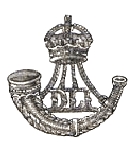
The Durham Light Infantry
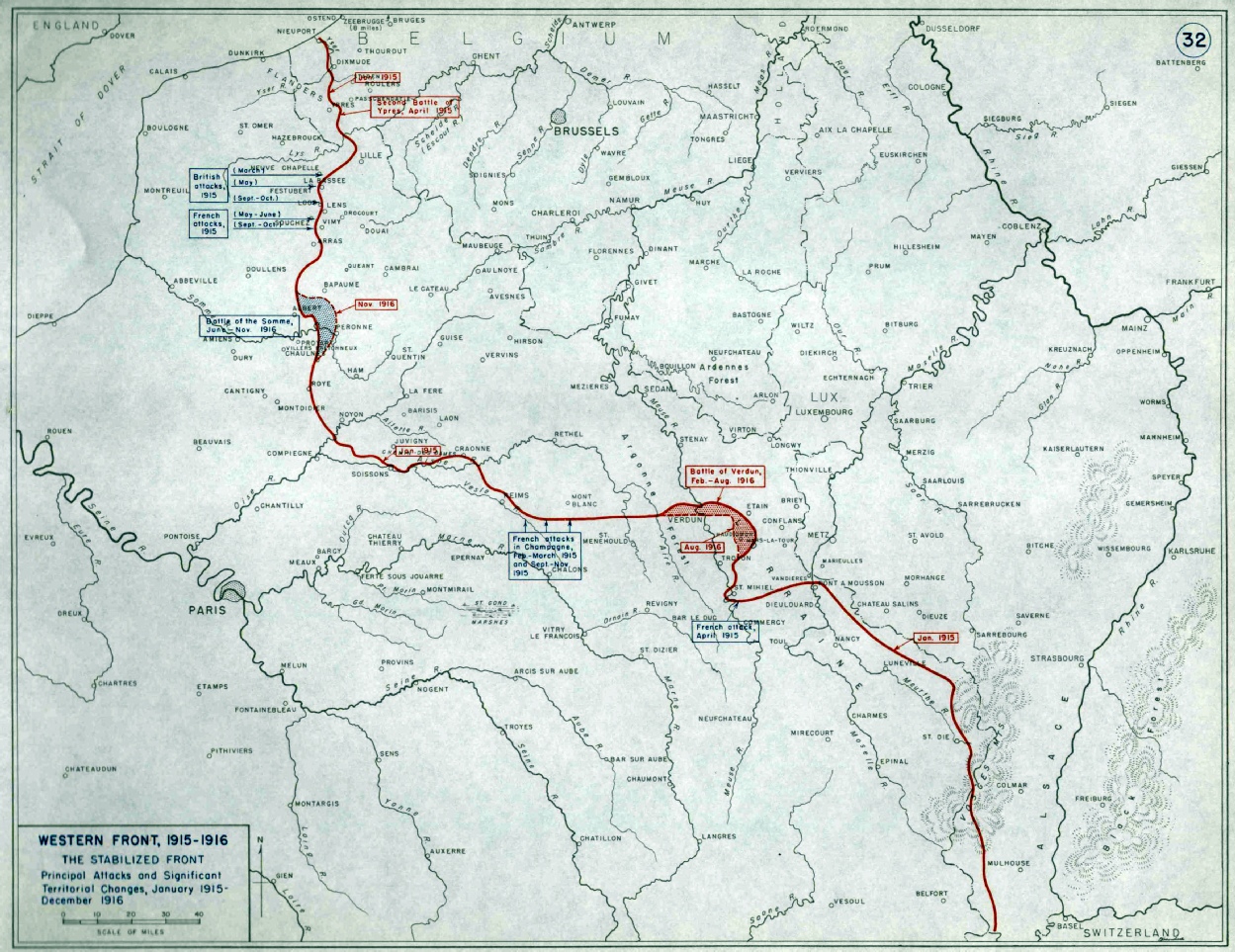

= Third Battle of Ypres
= First Battle of the Somme
= Second Battle of Arras

= German retreat to the Hindenburg Line
Hover your mouse over a circle
for more information
for more information
1917
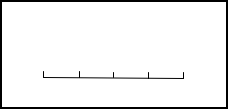
SCALE IN MILES
0
10
20
30
Western Front 1914 -1918
1918
